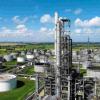A shell and tube heat exchanger is required to cool 75kg/s of oil from 500K to 450K by means of 100kg/s water entering at 350K.
How would one calculate the required surface area for the above-mentioned requirements for a partly counter-current and partly co-current heat exchanger?
DATA:
- Specific heat capacity of water is 4.2kJ/kg.K
- Specific heat capacity of oil is 3.0kJ/kg.K
- Overall heat transfer co-efficient is 4kW/m2.K
- Temperature correction factor is 0.75 with reference to counter-current flow

 FB
FB













